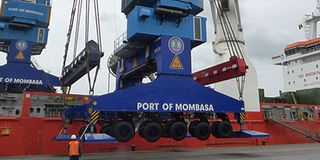Uganda remains biggest client of Mombasa port

Transit. Uganda transited more than 9.6 million tonnes of exports and imports through Mombasa. FILE PHOTO
What you need to know:
South Sudan: Juba recorded a slight growth last year to 170,469 tonnes from to 128,118 tonnes in 2017. Juba mostly imports wheat, oil, rice and sugar.
Kampala. Uganda accounted for more than a quarter of the business at the port of Mombasa in 2018, pushing the total transit volumes up by 10 per cent from 8.6 million tonnes in 2017 to 9.6 million tonnes.
Uganda remains a key trade partner for Kenya as its exports and imports passing through Mombasa are increasing.
The latest figures for 2018 from the Kenya Ports Authority annual performance report show that Uganda remained the leading Mombasa port user, with its import cargo rising steadily from 6.5 million tonnes in 2017 to 7.4 million tonnes of goods last year.
However, exports through Mombasa including tea, among others dropped from 522,876 tonnes in 2017 to 471,812 tonnes last year. Tea is one of Uganda’s biggest exports, mostly shipped to Pakistan and UK.
On average, Uganda exports about 60,000 tonnes indirectly through the Mombasa tea auction as Kenyan branded tea through 27 exporting companies.
In 2017, the country exported tea through the port of Mombasa worth $79.8m, up from $71.5m recorded in 2016. Uganda also exports tea to Sudan, Egypt and DR Congo.
Last year, Uganda was pushing to have its own auction and market its tea directly to buyers to get better prices for exporters.
Ugandan exporters held back some of their produce as they planned an alternative auction in Kampala, thus reducing the country’s exports via Mombasa port.
During President Museveni’s visit to Mombasa port recently, Kenya offered Uganda a piece of land in Naivasha to put up a dry port for its cargo.
The proposed Naivasha dry port, whose details are yet to be shared, will also see Uganda play a more crucial role for the hinterland countries, including Rwanda and DR Congo.
In July last year, Uganda started exporting coffee under a pilot scheme through the Single Customs Territory (SCT) - the seamless regional tax collection arrangement.
Under the SCT, Customs declarations have been reduced from four to one, while cross-border export clearance will take a maximum of two hours.
contribution from other countries
Uganda’s top 20 exports between July and December last year contributed 64.58 per cent of its total export revenue, valued at $896m of the total $1.34b. Currently, Uganda exports mostly coffee and tea via the Mombasa port. The Kenya Ports Authority report indicated Juba was the port’s second largest client for transit cargo, importing 563,663 tonnes of goods, a slight increase from the 545,634 tonnes imported through the port in 2017. In terms of exports, Juba recorded a slight growth last year to 170,469 tonnes from to 128,118 tonnes in 2017. Juba mostly imports wheat, oil, rice and sugar.
Tanzania imported 229,652 tonnes of cargo through Mombasa, a drop from 244,239 in 2017. Its exports also dropped from 27,459 in 2017 to 18,373 tonnes.
Most of the goods imported by Tanzania through Mombasa port head to the northern parts of the country through the Holili border post, given its easier access and distance than the longer Dar es Salaam route. Traffic to Burundi dropped from 21,578 tonnes in 2017 to 20,610 last year. However, there was a sharp rise in its exports from just four tonnes in 2017 to 1,623 last year. DR Congo remained the third largest transit cargo client for the Mombasa port, with its volumes rising to 413,249 tonnes last year from 317,096 in 2017.
EAC transit
South Sudan: Juba recorded a slight growth last year to 170,469 tonnes from to 128,118 tonnes in 2017. Juba mostly imports wheat, oil, rice and sugar.
Tanzania: The country imported 229,652 tonnes of cargo through Mombasa, a drop from 244,239 in 2017. Its exports also dropped from 27,459 in 2017 to 18,373 tonnes.
Burundi: Traffic to Burundi dropped from 21,578 tonnes in 2017 to 20,610 last year.
However, there was a sharp rise in exports from four tonnes in 2017 to 1,623 last year.




